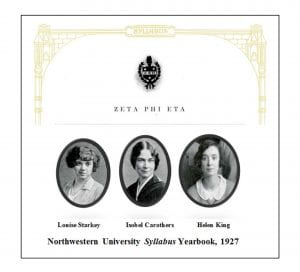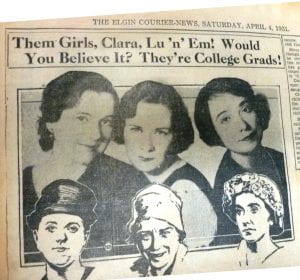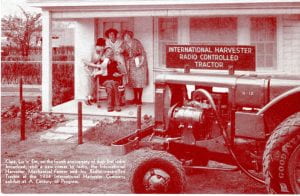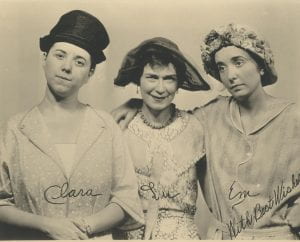On Dec 3, 2019, a new black-box theater space in Northwestern’s Wirtz Center for the Performing Arts was dedicated. The new theater’s dedication coincides neatly with the ongoing commemoration of “150 Years of Women at NU” —since the theater space is named for “Clara, Lu ‘n’ Em,” the alter-egos of three Northwestern alumnae who pioneered as writers, actors, and producers of an early radio soap opera.
From 1930-46, the daily conversations of three small-town housewives—exchanged over the back fence or during a kitchen-table kaffee-klatsch—were overheard by thousands of listeners across the United States. The womens’ chatter, dealing with familiar issues of family and friends, sprinkled with timely references to national and world events, and delivered in a folksy tone layered with comical mispronunciations and malapropisms, caught the ears of a new audience: women listening to the radio as they did their housework. The format (soon called “soap opera,” because the shows were usually sponsored by manufacturers of household products) became popular, and so did the three chatterboxes who starred in the Clara, Lu ‘n’ Em radio show.
But the plot twist in this story is that those rustic gossips with their prosaic lives and sloppy grammar were portrayed by three accomplished alumnae of Northwestern University’s School of Speech (now School of Communication), who not only wrote and performed every script, but also negotiated the complex world of sponsorships and network contracts.
MEET CLARA, LU ’N’ EM
 Who were the Northwestern graduates who achieved fame channeling plain-spoken housewives? Louise Starkey (1905-1969), from Des Moines, IA, graduated from Northwestern in 1927. Isobel Carothers (1900-1937), also from Des Moines, and Helen King (1904-1970), born in California but raised in Peoria, IL, both graduated in 1926. The three participated in drama societies at Northwestern and were members of the Zeta Phi Eta communications sorority. To entertain their sorority sisters, they would improvise humorous dialogues in the twang characteristic of their relatives back home, assuming the names “Clara” (Louise), “Lu” (Isobel), and “Em” (Helen).
Who were the Northwestern graduates who achieved fame channeling plain-spoken housewives? Louise Starkey (1905-1969), from Des Moines, IA, graduated from Northwestern in 1927. Isobel Carothers (1900-1937), also from Des Moines, and Helen King (1904-1970), born in California but raised in Peoria, IL, both graduated in 1926. The three participated in drama societies at Northwestern and were members of the Zeta Phi Eta communications sorority. To entertain their sorority sisters, they would improvise humorous dialogues in the twang characteristic of their relatives back home, assuming the names “Clara” (Louise), “Lu” (Isobel), and “Em” (Helen).
After graduation, they scattered across the country to pursue teaching or performing careers. When all three ended up back in Evanston by 1930, they put a radio act together, resurrecting the characters that had so amused the Zeta Phi Etas at NU.
The first radio station they approached turned them down without an audition, commenting that there was no place for women’s skits in radio. Next they tried WGN, Chicago’s NBC affiliate. Asked to describe their act, they said, “We talk…about anything.” The station manager told them to discuss Rudy Vallee—which they did with such charming chatter that they were offered a two-week trial on the local station. This was followed by a four-year contract which gave Clara, Lu ‘n’ Em a national audience on NBC stations, sponsored by SuperSuds, a dishwashing detergent produced by Colgate-Palmolive-Peet.
LET’S JOIN THOSE LOVABLE, LAUGHABLE HOUSEWIVES….
Clara, Lu ‘n’ Em was an early adopter of the “show about nothing” genre. They might comfortably discuss potatoes and politics in the same breath, or speculate for an entire show about whether women make decisions based on “’ductive reason” or “’tuition.” Listeners soon became well acquainted with the life stories of the “girls” (they were never called “women”) and their quintessential small city.
Why did so many people want to listen to three “zany housewives” talk about nothing, day after day? Were their audiences laughing with the three characters, or at them? Or both? And were Louise, Isobel, and Helen themselves laughing with or at Clara, Lu, and Em? Or both…
THEM GIRLS IS COLLEGE GRADS
The folksiness of the show was indeed part of its charm. Perhaps there was an element of nostalgia, with the girls’ naïve chatter representing an escape from the realities of the Depression. But another aspect of the program’s appeal seems to have been the contrast between the characters and the women who portrayed them. Press releases and newspaper interviews made no secret of the fact that the “three chatterbox gals, those neighborhood nitwits, queens of the washtub” from Anytown, USA, were played by intelligent, sophisticated college graduates.
Interviewers were particularly intrigued by the way the performers managed to pursue their careers while raising families. By 1935, the three women behind the scenes were married (becoming Louise Mead, Isobel Berolzheimer, and Helen Mitchell) and had their first children, while continuing to write and perform five shows per week. Their original weekly salary of $150 from WGN had become $1,500, supplemented by earnings from personal appearances. They—or rather their alter egos—had traveled to Washington DC to attend FDR’s inauguration, lunched at the Empire State Building with NY governor Al Smith, and inspected International Harvester tractors at the 1933 Century of Progress World’s Fair.

[SOUND: DRAMATIC MUSIC]
Then, in December, 1935, on the grounds that audiences wanted something different, Colgate dropped its sponsorship of Clara, Lu ‘n’ Em. The program was immediately picked up by Frigidaire as a weekly show. However, in January, 1937, Isobel (“Lu”) died of pneumonia, and Clara, Lu ‘n’ Em soon went off the air.
BACK ON THE AIR
Louise (“Clara”) and Helen (“Em”) worked to revive the show, and in June 1942, they reappeared on CBS, sponsored by Pillsbury Flour. Harriet Allyn Crowley, another NU School of Speech alumna, became the new “Lu.” But despite the patriotic content of their wartime scripts, the show was pulled in December. After one last try in 1945-6, with a new cast which included Fran Allison (later of Kukla, Fran & Ollie), and sponsored by Kitchen Klenzer (a soap opera to the last), Clara, Lu, and Em said their final “g’nights.”
TUNE IN AGAIN
But there’s a happy ending to this daytime drama. In addition to having their very own theater space, “them girls” live on in the Northwestern University Archives’ Clara, Lu ‘n’ Em collection, which includes documents, scripts, posters, photographs, audio, and artifacts. (All items pictured here are from the collection.) The collection sheds light not only on this particular program, but also on an era when radio drama was still developing, and when homespun housewives had an appeal later superseded by steamier characters and plots as the soap opera genre matured.*
Wouldn’t Louise, Isobel, and Helen be proud to know that they have a theater named for them, and that they are considered “catalysts” during this year of NU women? (And imagine Clara, Lu, and Em discussing the term “catalyst.”)
*In another plot twist, NU Archives also holds the papers of Agnes Nixon, the Emmy-winning creator of later radio and TV soap operas, including All My Children.
Fall, 2019, marked 150 years since women could enroll as Northwestern undergraduate students. As the University collectively commemorates this milestone — and the women/womxn who have shaped Northwestern — the Northwestern community will have many opportunities to reflect, be inspired and learn from each other. Throughout the academic year, events and programming will be held across the entire University and around the world. Visit the 150 years of women website (https://www.northwestern.edu/150-years-of-women/) to learn more and get involved.



